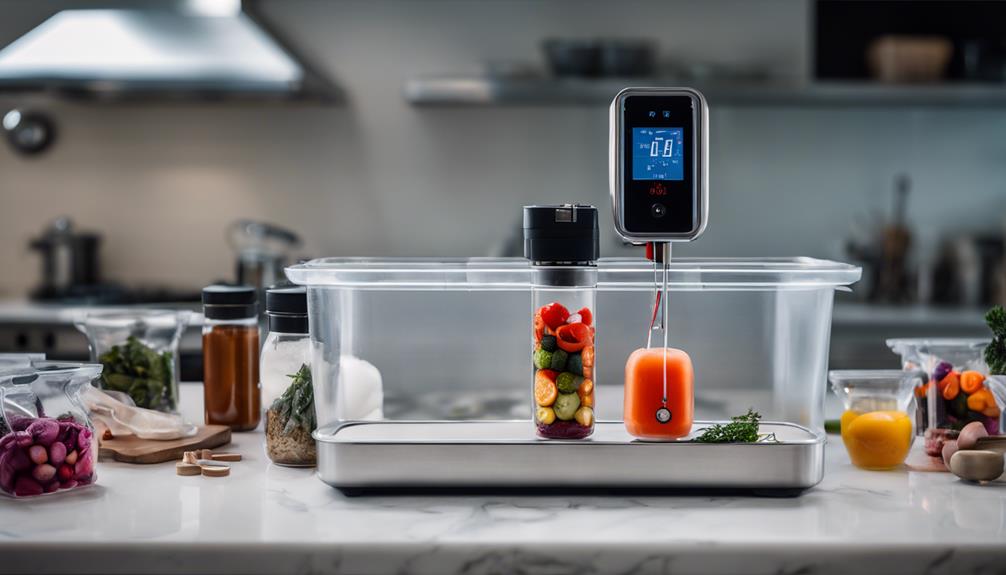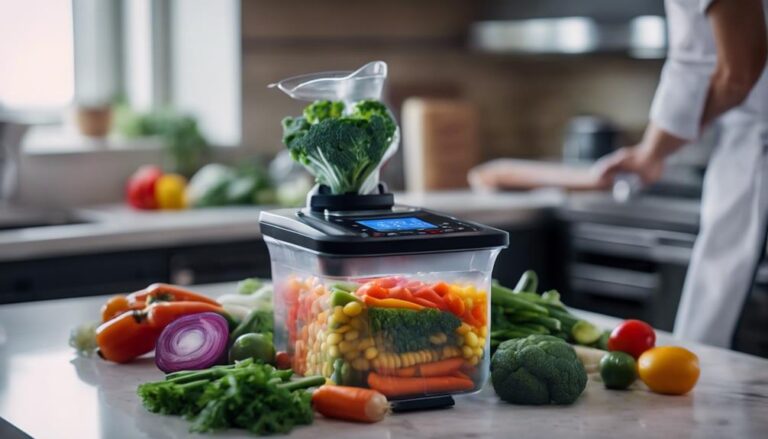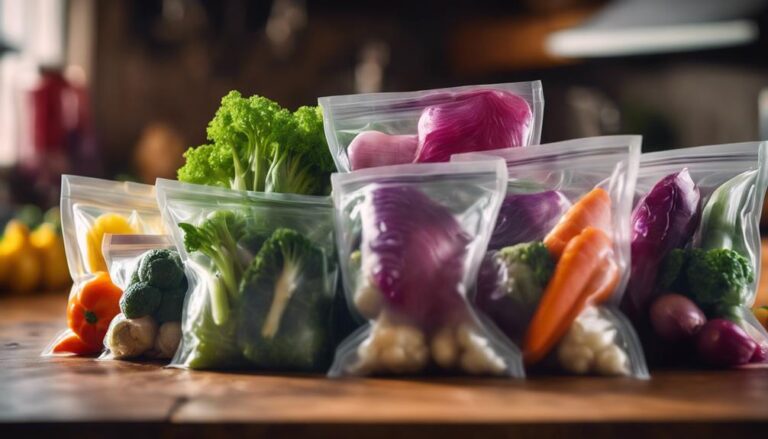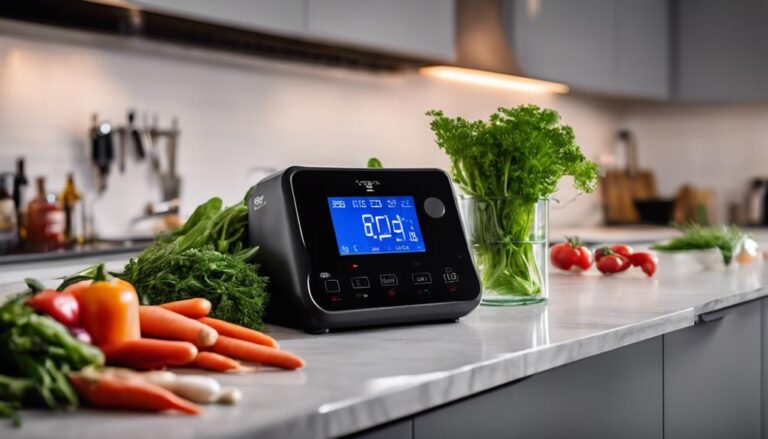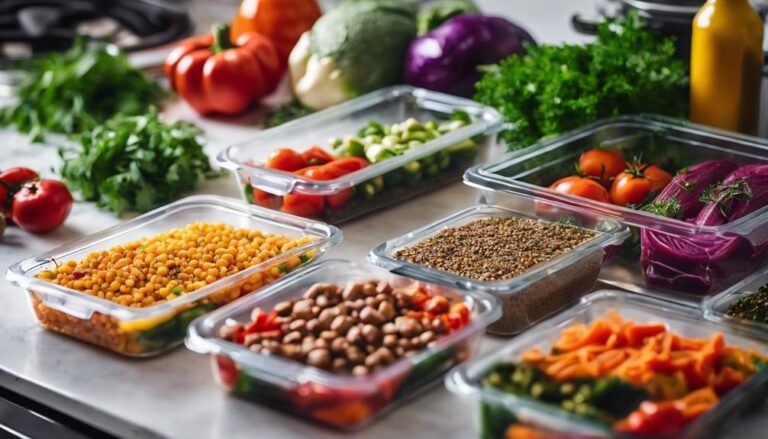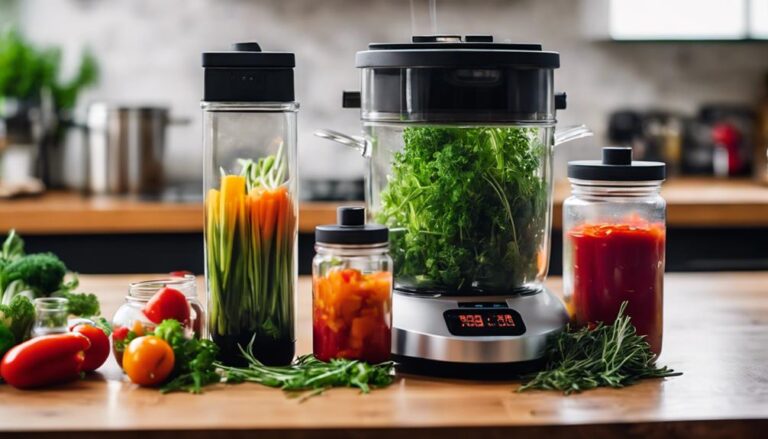How to Avoid Common Mistakes in Sous Vide Cooking
To avoid common mistakes in sous vide cooking, focus on technique and equipment. Always preheat your water bath before adding food to guarantee even cooking. Use high-quality vacuum-sealed bags to prevent leaks, and avoid overcrowding to allow proper water circulation. Handle bags carefully with long tongs to prevent punctures, and check water levels regularly to avoid evaporation. Pay attention to cooking times and temperatures, as they vary by ingredient. Finally, dry your food before searing for a better crust. Mastering these elements will lead to more consistent and delicious results, and there's more to explore.
What You Will Learn Here
- Use high-quality sous vide bags to prevent leaks and ensure consistent cooking results.
- Preheat the water bath to the desired temperature before adding food for even cooking.
- Avoid overcrowding the water bath to allow proper water circulation around each bag.
- Regularly check water levels and cover the container to prevent evaporation during cooking.
Common Sous Vide Mistakes
One of the biggest pitfalls in sous vide cooking is mishandling bags, which can lead to leaks and ruin your meal. To guarantee success, always use high-quality sous vide bags and a vacuum sealer. Avoid sharp objects near the bags to prevent punctures.
Another common mistake is overcrowding the water bath. This impedes ideal water flow, leading to uneven cooking. Make sure there's adequate space between each bag to allow for proper circulation.
Don't drop proteins directly into the water bath without sealing them; this can cause them to bond together, ruining texture and flavor. Always seal your food in bags for consistent results.
It's also essential to monitor water levels throughout the cooking process. If you neglect this, evaporation can occur, compromising your meal. Cover the container and check levels regularly to prevent spoilage.
Temperature and Time Missteps
Missteps in temperature and time can lead to unsafe cooking conditions and undesirable textures in your sous vide dishes. It's crucial to understand how to manage the temperature of the food and cooking time for ideal results.
Here are three key points to remember:
- Preheat Your Water Bath: Always preheat the water bath to the desired cooking temperature before adding your food. This guarantees even cooking and prevents cold water from extending cooking times.
- Know Your Cooking Times: Different foods require specific cooking times. For example, thicker cuts of steak may need longer to be properly pasteurized, while cooking sous vide at low temperatures can increase safety risks if left unattended too long.
- Avoid Extended Cooking: While sous vide allows for flexibility, extended cooking can lead to undesirable textures. Food left in the water bath for too long may lose its appealing qualities.
Proper Bag Handling Techniques
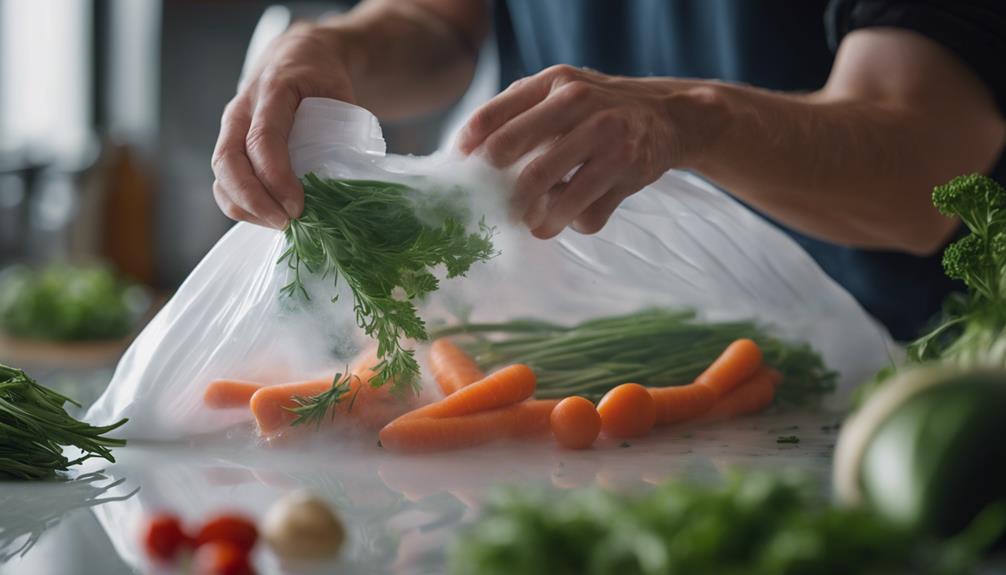
Ensuring proper bag handling techniques is essential for achieving consistent and safe results in sous vide cooking. Start by using high-quality vacuum sealers to create vacuum-sealed bags that prevent air pockets. Air pockets can cause bags to float, leading to uneven cooking, which you definitely want to avoid when serving others.
Remember not to overfill bags, as this can hinder the circulation of water around the food, affecting cooking efficiency. When it comes to handling the bags, always use long tongs. This helps you avoid puncturing the bags, which could lead to food contamination and spoilage.
For delicate items like eggs, place them in pouches or strainer baskets to protect them during cooking. This way, you'll prevent any cracking that can ruin both the presentation and taste.
Searing and Flavor Enhancements
Searing your meat after sous vide cooking not only enhances its flavor but also creates a delicious crust that elevates your dish. To achieve a good sear and maximize flavor enhancements, follow these key steps:
- Dry the Surface: Make sure to dry your meat thoroughly before searing. This prevents steam from forming, which can hinder browning and keep your crust from being as crispy as it should be.
- Use High-Quality Fats: Opt for high-quality fats like clarified butter or avocado oil during the searing process. These fats can greatly boost the flavor profile of your perfectly cooked meat.
- Incorporate Aromatics: Add herbs and spices during the searing stage for deeper flavor infusion. This technique allows you to enhance the taste without the risk of burning the aromatics, which can happen if added too early.
Lastly, don't forget to preheat your plates before serving. This simple step helps maintain the temperature of your dish, ensuring a delightful dining experience for your guests.
Ingredient Preparation Essentials
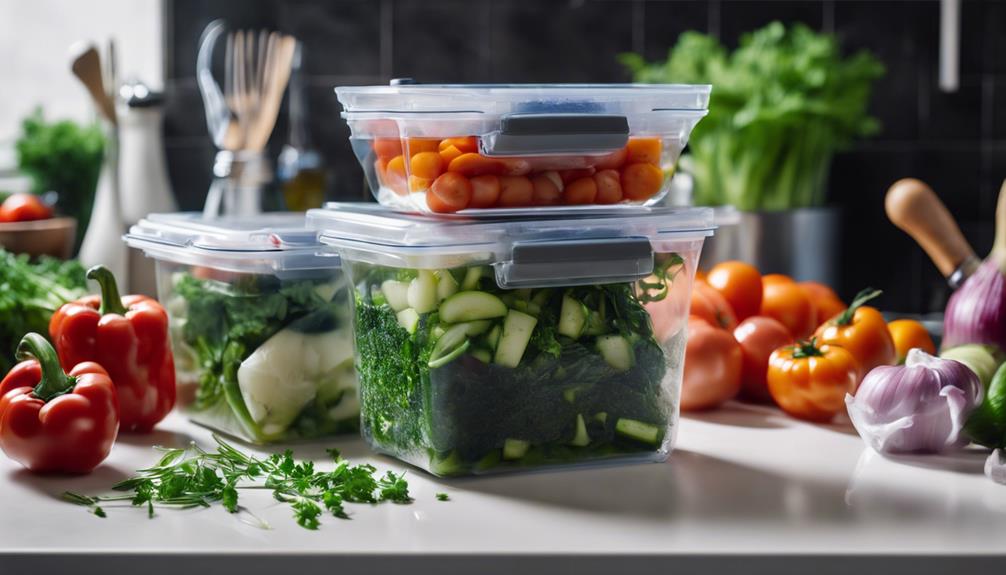
When preparing ingredients for sous vide cooking, it's vital to dry them properly to enhance the final sear and flavor. Excess moisture can hinder the enjoyment of your dish, especially with sous vide steak or other proteins. Start by guaranteeing all your foods are free from excess water.
Next, focus on ingredient preparation by cutting proteins and vegetables into uniform sizes. This promotes even cooking, preventing some portions from overcooking while others remain undercooked.
When it comes to seasoning, remember that sous vide intensifies flavors over time. Lightly season your ingredients before cooking, but consider adding more seasoning after cooking to avoid overpowering the dish.
Utilizing proper vacuum sealing techniques is significant as well. Confirm air removal from the bags to prevent them from floating during cooking, which can disrupt water circulation and lead to uneven results.
If you're cooking vegetables, pre-cook them at higher temperatures to retain their texture and flavor, as sous vide temperatures are generally lower for meats.
Water Management Tips
Effective water management is vital for achieving consistent and delicious results in sous vide cooking. By paying attention to your sous vide bath, you can enhance the overall quality of your dishes. Here are some key tips to keep in mind:
- Regularly check the water level: Make certain to maintain proper water levels to prevent exposure to air, which can lead to uneven cooking.
- Preheat your water bath: Set your sous vide bath to the desired temperature before adding your food. This guarantees that cooking starts at the right temperature, preventing longer cooking times and inconsistent results.
- Avoid overcrowding: Giving your ingredients enough space allows for better circulation, which is essential for achieving a consistent temperature throughout.
Additionally, consider using a lid or weights to fully submerge your bags. This not only prevents floating but also promotes better water circulation.
Covering your container can effectively prevent water evaporation during long cooking times, making sure that your food remains perfectly cooked.
Cooking Equipment Considerations
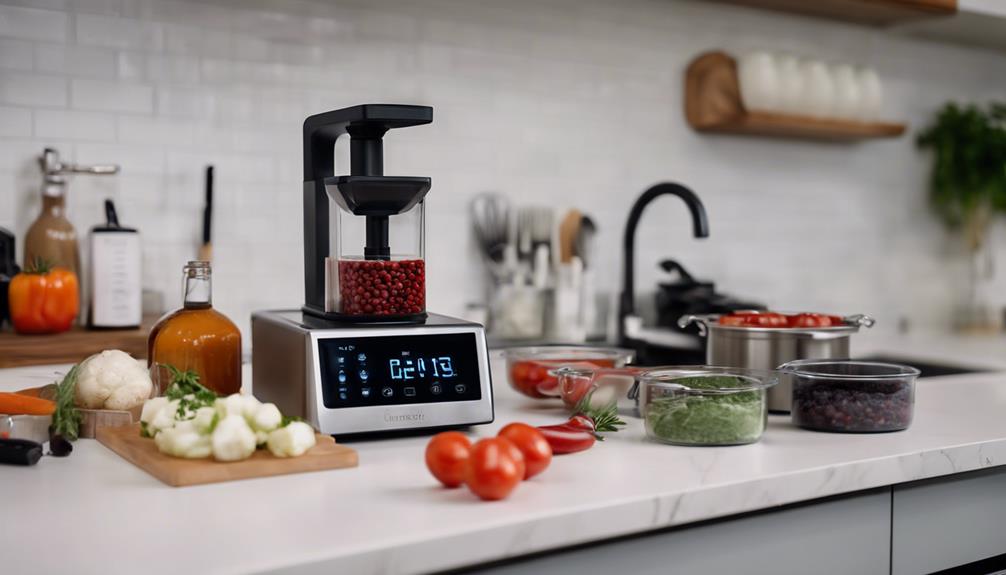
Selecting the right cooking equipment is essential for mastering sous vide, guaranteeing you achieve precise temperature control and consistent results every time.
Start with a high-quality immersion circulator; it must maintain the desired temperature accurately. Regularly calibrate your sous vide machine to prevent cooking errors caused by incorrect readings.
When it comes to sealing your food, invest in vacuum sealers specifically designed for sous vide. They create airtight seals that prevent leaks and air pockets, which can lead to uneven cooking. Avoid using Ziploc bags, as they often fail to provide the necessary seal.
Choose a heat-safe container that can hold your water bath without warping. Improper materials can leach chemicals into your food, compromising safety and flavor.
Additionally, confirm your sous vide machine has sufficient wattage—aim for at least 800 watts. Higher wattage means quicker heating, allowing you to reach the desired temperature without prolonging cooking times.
Frequently Asked Questions
What Are the Problems With Sous Vide Cooking?
When you sous vide, you might face sous vide safety concerns, overcooking issues, and flavor loss. Equipment malfunctions, temperature accuracy, and improper vacuum sealing can affect food texture and cooking times, impacting your meal prep efforts.
What Are 5 Tips for Using Sous Vide?
When using sous vide techniques, guarantee proper temperature control and vacuum sealing for flavor infusion. Monitor cooking times for food safety, use sous vide accessories for meal prep, and enjoy recipe experimentation for texture enhancement while serving others.
What Is the Secret of Sous Vide?
The secret of sous vide is its precision. You benefit from consistent temperatures, enhancing flavors while ensuring safety. With proper techniques and equipment, you'll create delicious recipes, embracing trends that elevate your culinary skills for serving others.
Why Is My Steak Still Tough After Sous Vide?
If your steak's still tough after sous vide, it could be due to insufficient cooking time, low meat quality, or improper sous vide temperature. Verify you've vacuum sealed properly, rested enough, and selected the right cut for tenderness.
Conclusion
By avoiding common mistakes in sous vide cooking, you can achieve delicious and perfectly cooked meals every time.
Pay attention to temperature and time, handle bags properly, and focus on ingredient preparation.
Don't forget to manage your water levels and invest in quality equipment.
With these tips, you'll enhance your cooking skills and enjoy the benefits of this precise method.
Remember, practice makes perfect, so keep experimenting to find what works best for you.
